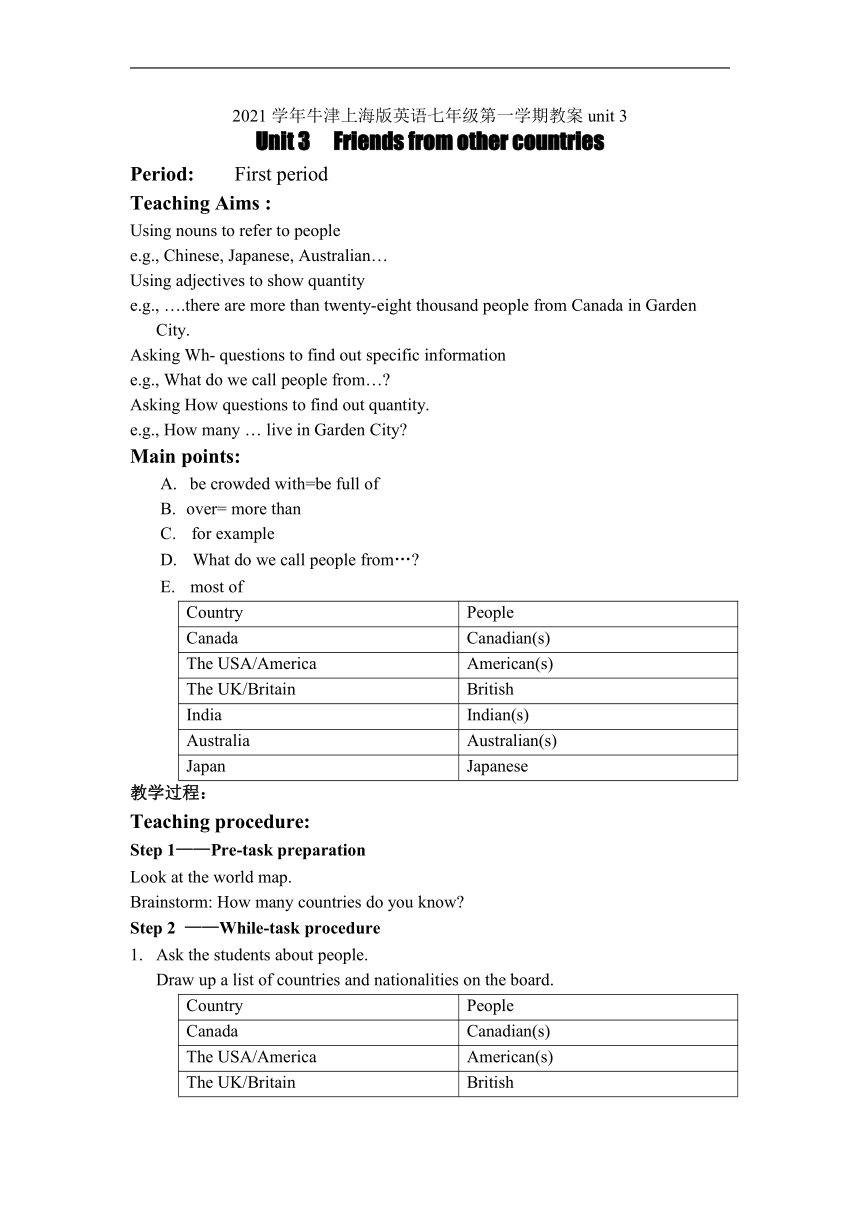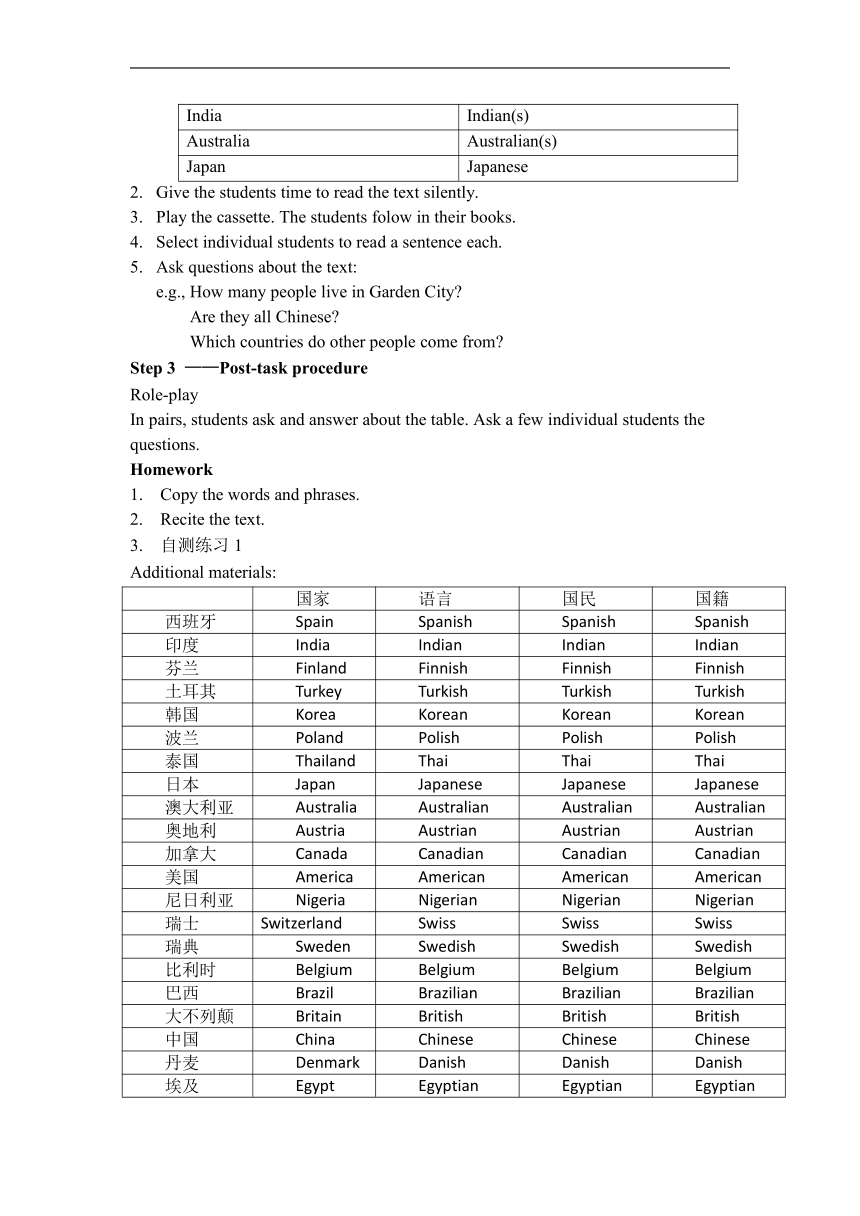牛津上海版英语七年级上册 Unit 3 Friends from other countries 教案(3课时)
文档属性
| 名称 | 牛津上海版英语七年级上册 Unit 3 Friends from other countries 教案(3课时) |

|
|
| 格式 | docx | ||
| 文件大小 | 27.5KB | ||
| 资源类型 | 教案 | ||
| 版本资源 | 牛津上海版(试用本) | ||
| 科目 | 英语 | ||
| 更新时间 | 2021-09-18 17:47:43 | ||
图片预览


文档简介
2021学年牛津上海版英语七年级第一学期教案unit
3
Unit
3
Friends
from
other
countries
Period:
First
period
Teaching
Aims
:
Using
nouns
to
refer
to
people
e.g.,
Chinese,
Japanese,
Australian…
Using
adjectives
to
show
quantity
e.g.,
….there
are
more
than
twenty-eight
thousand
people
from
Canada
in
Garden
City.
Asking
Wh-
questions
to
find
out
specific
information
e.g.,
What
do
we
call
people
from…?
Asking
How
questions
to
find
out
quantity.
e.g.,
How
many
…
live
in
Garden
City?
Main
points:
A.???
be
crowded
with=be
full
of
B.????over=
more
than
C.????
for
example
D.??
What
do
we
call
people
from…?
E.????
most
of
Country
People
Canada
Canadian(s)
The
USA/America
American(s)
The
UK/Britain
British
India
Indian(s)
Australia
Australian(s)
Japan
Japanese
教学过程:
Teaching
procedure:
Step
1——Pre-task
preparation
Look
at
the
world
map.
Brainstorm:
How
many
countries
do
you
know?
Step
2
——While-task
procedure
Ask
the
students
about
people.
Draw
up
a
list
of
countries
and
nationalities
on
the
board.
Country
People
Canada
Canadian(s)
The
USA/America
American(s)
The
UK/Britain
British
India
Indian(s)
Australia
Australian(s)
Japan
Japanese
Give
the
students
time
to
read
the
text
silently.
Play
the
cassette.
The
students
folow
in
their
books.
Select
individual
students
to
read
a
sentence
each.
Ask
questions
about
the
text:
e.g.,
How
many
people
live
in
Garden
City?
Are
they
all
Chinese?
Which
countries
do
other
people
come
from?
Step
3
——Post-task
procedure
Role-play
In
pairs,
students
ask
and
answer
about
the
table.
Ask
a
few
individual
students
the
questions.
Homework
Copy
the
words
and
phrases.
Recite
the
text.
自测练习1
Additional
materials:
国家
语言
国民
国籍
西班牙
Spain
Spanish
Spanish
Spanish
印度
India
Indian
Indian
Indian
芬兰
Finland
Finnish
Finnish
Finnish
土耳其
Turkey
Turkish
Turkish
Turkish
韩国
Korea
Korean
Korean
Korean
波兰
Poland
Polish
Polish
Polish
泰国
Thailand
Thai
Thai
Thai
日本
Japan
Japanese
Japanese
Japanese
澳大利亚
Australia
Australian
Australian
Australian
奥地利
Austria
Austrian
Austrian
Austrian
加拿大
Canada
Canadian
Canadian
Canadian
美国
America
American
American
American
尼日利亚
Nigeria
Nigerian
Nigerian
Nigerian
瑞士
Switzerland
Swiss
Swiss
Swiss
瑞典
Sweden
Swedish
Swedish
Swedish
比利时
Belgium
Belgium
Belgium
Belgium
巴西
Brazil
Brazilian
Brazilian
Brazilian
大不列颠
Britain
British
British
British
中国
China
Chinese
Chinese
Chinese
丹麦
Denmark
Danish
Danish
Danish
埃及
Egypt
Egyptian
Egyptian
Egyptian
英格兰
England
English
English
English
法国
France
French
French
French
德国
Germany
German
German
German
希腊
Greece
Greek
Greek
Greek
匈牙利
Hungary
Hungarian
Hungarian
Hungarian
意大利
Italy
Italian
Italian
Italian
日本
Japan
Japanese
Japanese
Japanese
墨西哥
Mexico
Mexican
Mexican
Mexican
葡萄牙
Portugal
Portuges
Portuges
Portuges
俄罗斯
Russia
Russian
Russian
Russian
挪威
Norway
Norwegian
Norwegian
Norwegian
荷兰
Holland
Dutch
Dutch
Dutch
Period:
Second
period
Teaching
Aims
:
Asking
Wh-
questions
to
find
out
specific
information
e.g.,
Which
country
have
you
visited
or
read
about?
Using
the
present
perfect
tense
to
relate
past
events
to
the
present
e.g.,
I’ve
visited
Japan.
Using
prepositions
to
indicate
position
e.g.,
It’s
near/far
away
from
China.
Using
modal
verbs
to
make
an
invitation
e.g.,
Would
you
like
to
write
to
a
penfriend
in
another
country?
Main
points:
A.???
Would
you
like
to…?
B.????write
to
sb.
C.????interest
D.???
favourite
subject
at
school
Teaching
procedure:
Warm
up:
organize
a
dictation
about
Page
17
Nowadays,
near,
far
away
from,
visit,
read
about,
magazine
,the
UK,
Japan,
China,
India.
Step
1——Pre-task
preparation
Imagine
you
have
a
net
friend.
Make
a
list
about
what
you
want
to
know.
What
is
your
nationality?
How
old
are
you?
How
many
people
are
there
in
your
family?
Do
you
have
any
pets?
Which
school
do
you
go
to
?
What
are
your
favorite
subjects?
What
do
you
like
doing
after
school?
Kitty
has
made
a
list.
She
wants
to
know
somethings
about
her
penfriend.
Look
and
say
what
she
would
like
to
know
about
her
penfriend.
She
would
like
to
know….
Step
2
——While-task
procedure
Play
the
cassette
for
the
dialogue.
The
students
listen
and
read
the
text
again.
Ask
individual
students:
Who
would
you
like
to
write
a
letter
to
?
Step
3
——Post-task
procedure
Tick
the
things
you
want
to
know
about
your
penfriend.
With
a
classmate,
ask
and
answer
questions.
S1:
What
would
you
like
to
know
about
your
penfriend?
S2:
I’d
like
to
know
(about)
his/her
_____.
Homework:
Copy
and
recite
the
words,
phrases
and
text
Write
an
e-mail
to
your
net
friend
to
introduce
yourself.
Period:
Third
period
Teaching
Aims:
Using
modal
verbs
to
express
wishes.
e.g.,
I
would
like
to
be
your
penfriend
,
too.
Using
prepositions
to
indicate
place
e.g.,
I
am
a
boy
from
Canada.
Using
formulaic
expressions
begin
and
end
a
letter.
e.g.,
Dear
Kitty;
Yours
Main
points:
Writing
a
letter
to
introduce
them
Teaching
procedure:
Step
1——Pre-task
preparation
Ask
the
students
to
read
the
letter
on
page
19
of
Student’s
Book
7A
again
Step
2
——While-task
procedure
Give
the
students
time
to
read
the
list.
Ask
questions
about
the
list:
e.g.,
Is
Gary
a
boy
or
a
girl?
Where
does
he
come
from?
How
old
is
he?
How
many
people
are
there
in
his
family?
Does
he
have
a
pet?
Complete
the
letter
orally.
The
students
write
their
answers.
Ask
individual
students
to
read
out
a
sentence.
Step
3——Post-task
activities
Workbook
7A
pages
20-21
The
students
complete
the
list
about
themselves
on
page
20
In
pairs,
students
discuss
how
to
complete
the
letter
on
page
21.
The
students
then
write
their
letter.
Select
one
or
two
students
to
read
their
letter.
3
Unit
3
Friends
from
other
countries
Period:
First
period
Teaching
Aims
:
Using
nouns
to
refer
to
people
e.g.,
Chinese,
Japanese,
Australian…
Using
adjectives
to
show
quantity
e.g.,
….there
are
more
than
twenty-eight
thousand
people
from
Canada
in
Garden
City.
Asking
Wh-
questions
to
find
out
specific
information
e.g.,
What
do
we
call
people
from…?
Asking
How
questions
to
find
out
quantity.
e.g.,
How
many
…
live
in
Garden
City?
Main
points:
A.???
be
crowded
with=be
full
of
B.????over=
more
than
C.????
for
example
D.??
What
do
we
call
people
from…?
E.????
most
of
Country
People
Canada
Canadian(s)
The
USA/America
American(s)
The
UK/Britain
British
India
Indian(s)
Australia
Australian(s)
Japan
Japanese
教学过程:
Teaching
procedure:
Step
1——Pre-task
preparation
Look
at
the
world
map.
Brainstorm:
How
many
countries
do
you
know?
Step
2
——While-task
procedure
Ask
the
students
about
people.
Draw
up
a
list
of
countries
and
nationalities
on
the
board.
Country
People
Canada
Canadian(s)
The
USA/America
American(s)
The
UK/Britain
British
India
Indian(s)
Australia
Australian(s)
Japan
Japanese
Give
the
students
time
to
read
the
text
silently.
Play
the
cassette.
The
students
folow
in
their
books.
Select
individual
students
to
read
a
sentence
each.
Ask
questions
about
the
text:
e.g.,
How
many
people
live
in
Garden
City?
Are
they
all
Chinese?
Which
countries
do
other
people
come
from?
Step
3
——Post-task
procedure
Role-play
In
pairs,
students
ask
and
answer
about
the
table.
Ask
a
few
individual
students
the
questions.
Homework
Copy
the
words
and
phrases.
Recite
the
text.
自测练习1
Additional
materials:
国家
语言
国民
国籍
西班牙
Spain
Spanish
Spanish
Spanish
印度
India
Indian
Indian
Indian
芬兰
Finland
Finnish
Finnish
Finnish
土耳其
Turkey
Turkish
Turkish
Turkish
韩国
Korea
Korean
Korean
Korean
波兰
Poland
Polish
Polish
Polish
泰国
Thailand
Thai
Thai
Thai
日本
Japan
Japanese
Japanese
Japanese
澳大利亚
Australia
Australian
Australian
Australian
奥地利
Austria
Austrian
Austrian
Austrian
加拿大
Canada
Canadian
Canadian
Canadian
美国
America
American
American
American
尼日利亚
Nigeria
Nigerian
Nigerian
Nigerian
瑞士
Switzerland
Swiss
Swiss
Swiss
瑞典
Sweden
Swedish
Swedish
Swedish
比利时
Belgium
Belgium
Belgium
Belgium
巴西
Brazil
Brazilian
Brazilian
Brazilian
大不列颠
Britain
British
British
British
中国
China
Chinese
Chinese
Chinese
丹麦
Denmark
Danish
Danish
Danish
埃及
Egypt
Egyptian
Egyptian
Egyptian
英格兰
England
English
English
English
法国
France
French
French
French
德国
Germany
German
German
German
希腊
Greece
Greek
Greek
Greek
匈牙利
Hungary
Hungarian
Hungarian
Hungarian
意大利
Italy
Italian
Italian
Italian
日本
Japan
Japanese
Japanese
Japanese
墨西哥
Mexico
Mexican
Mexican
Mexican
葡萄牙
Portugal
Portuges
Portuges
Portuges
俄罗斯
Russia
Russian
Russian
Russian
挪威
Norway
Norwegian
Norwegian
Norwegian
荷兰
Holland
Dutch
Dutch
Dutch
Period:
Second
period
Teaching
Aims
:
Asking
Wh-
questions
to
find
out
specific
information
e.g.,
Which
country
have
you
visited
or
read
about?
Using
the
present
perfect
tense
to
relate
past
events
to
the
present
e.g.,
I’ve
visited
Japan.
Using
prepositions
to
indicate
position
e.g.,
It’s
near/far
away
from
China.
Using
modal
verbs
to
make
an
invitation
e.g.,
Would
you
like
to
write
to
a
penfriend
in
another
country?
Main
points:
A.???
Would
you
like
to…?
B.????write
to
sb.
C.????interest
D.???
favourite
subject
at
school
Teaching
procedure:
Warm
up:
organize
a
dictation
about
Page
17
Nowadays,
near,
far
away
from,
visit,
read
about,
magazine
,the
UK,
Japan,
China,
India.
Step
1——Pre-task
preparation
Imagine
you
have
a
net
friend.
Make
a
list
about
what
you
want
to
know.
What
is
your
nationality?
How
old
are
you?
How
many
people
are
there
in
your
family?
Do
you
have
any
pets?
Which
school
do
you
go
to
?
What
are
your
favorite
subjects?
What
do
you
like
doing
after
school?
Kitty
has
made
a
list.
She
wants
to
know
somethings
about
her
penfriend.
Look
and
say
what
she
would
like
to
know
about
her
penfriend.
She
would
like
to
know….
Step
2
——While-task
procedure
Play
the
cassette
for
the
dialogue.
The
students
listen
and
read
the
text
again.
Ask
individual
students:
Who
would
you
like
to
write
a
letter
to
?
Step
3
——Post-task
procedure
Tick
the
things
you
want
to
know
about
your
penfriend.
With
a
classmate,
ask
and
answer
questions.
S1:
What
would
you
like
to
know
about
your
penfriend?
S2:
I’d
like
to
know
(about)
his/her
_____.
Homework:
Copy
and
recite
the
words,
phrases
and
text
Write
an
to
your
net
friend
to
introduce
yourself.
Period:
Third
period
Teaching
Aims:
Using
modal
verbs
to
express
wishes.
e.g.,
I
would
like
to
be
your
penfriend
,
too.
Using
prepositions
to
indicate
place
e.g.,
I
am
a
boy
from
Canada.
Using
formulaic
expressions
begin
and
end
a
letter.
e.g.,
Dear
Kitty;
Yours
Main
points:
Writing
a
letter
to
introduce
them
Teaching
procedure:
Step
1——Pre-task
preparation
Ask
the
students
to
read
the
letter
on
page
19
of
Student’s
Book
7A
again
Step
2
——While-task
procedure
Give
the
students
time
to
read
the
list.
Ask
questions
about
the
list:
e.g.,
Is
Gary
a
boy
or
a
girl?
Where
does
he
come
from?
How
old
is
he?
How
many
people
are
there
in
his
family?
Does
he
have
a
pet?
Complete
the
letter
orally.
The
students
write
their
answers.
Ask
individual
students
to
read
out
a
sentence.
Step
3——Post-task
activities
Workbook
7A
pages
20-21
The
students
complete
the
list
about
themselves
on
page
20
In
pairs,
students
discuss
how
to
complete
the
letter
on
page
21.
The
students
then
write
their
letter.
Select
one
or
two
students
to
read
their
letter.
同课章节目录
- Module 1 Relationships
- Unit 1 Relationships in beijing
- Unit 2 Our animal friends
- Unit 3 Friends from other countries
- Module 2 My Neighborhood
- Unit 4 Jobs people do
- Unit 5 Choosing a new flat
- Unit 6 Different places
- Unit 7 Signs around us
- Module 3 Diet and health
- Unit 8 Growing healthy,growing
- Unit 9 International Food Festival
- Unit 10 A birthday party
- Unit 11 My food project
